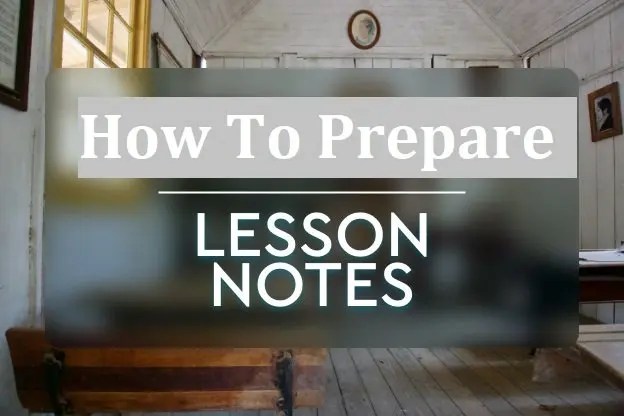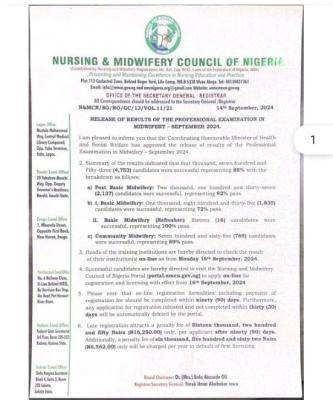
Effective teaching and learning do not just happen, they are a product of planning. The quality of teaching is enhanced greatly by planning. Every good teacher should plan his lessons well before giving them. If proper planning takes place, teaching is enhanced. The lesson note is the main tool of the teacher in the teaching-learning process which is often misplaced with lesson plan.
This article will help all teachers, assistant teachers and all who are in the educational sector especially in Nursery, Primary and Secondary school level the step By step approach on how to write lesson note for any subject offered in the above levels.
At the end of this post you should have learnt the following;
- All about lesson notes
- How to write a good lesson note for any subject and class you are teaching
- Qualities of a good lesson note
- Contents and features of a good lesson note
- Imperatives in Teacher’s lesson notes
- Scheme of work and syllabus
CONTENT OF A GOOD LESSON NOTE
A good lesson note should contain the following:
(i) Date
(ii) Class
(iii) Subject
(iv) Topic
(v) Aspect
(vi) Periods
(vii) Duration
(viii) Reference books
(ix) Teaching materials
(x) Previous knowledge
(xi) Objective
(xii) Content
(xiii) Presentation/ Methods
(xiv) Evaluation/ Assignment
(xv) Summary
A good plan must specify terms the objectives to be achieved as a result of the plan in behavioral terms, that is in terms of observable behavior.
INTERPRETATION OF THE SYLLABUS/ CURRICULUM
The major responsibility of the classroom teacher begins with the interpretation of the school syllabus/ curriculum, and the scheme of work. It is relevant to note that while lesson notes are derivable from
scheme of work, the latter are usually drawn out of syllabus which itself is derived from the curriculum.
THE CURRICULUM
Curriculum is all the planned experiences which the school wants its pupils to have. The curriculum usually has a format showing in separate columns. The theme/ unit/ topic. The objectives, the content the suggested teaching methods and activities, the suggested teaching materials and the evaluation.
THE SYLLABUS
The syllabus like the curriculum, may be described as a course of work planned to span a period of time. It usually indicates the periods of work planned for a school for a term or one academic year. It is not as broad-based as the curriculum. A syllabus normally has a list of topics to be covered within a given period. Like the curriculum.
A syllabus takes into consideration such factors as:
- Relevance of the syllabus to the needs of individual pupils and the society
- Its suitability for the age of the pupils.
- Consideration for and the knowledge work intended or skills already acquired by the pupils/ students for the future years.
- Relationship/ linkage with other school subjects, and
- Consideration for ability to complete the amount allotted time. of work in the
SCHEME OF WORK
Scheme of work means plan of work, thus a scheme of work may be defined as the breaking down of the topics from either the curriculum or the syllabus to workable unit. In doing this, age, intellectual ability,
educational and maturity of students should background be taken into consideration. The time allotted to the particular subject is also to be borne in mind. The relationship between lesson preparation and the topics in the syllabus is very crucial, significant, relevant and intimate. This is because the teacher has taken each topic in the syllabus and break it into series of lessons which will adequately over the topic.
Such a series of lesson which will adequately over the topic, and such a series of lessons is what is known as a scheme of work.
A good scheme of work must contain the following;
i. Have an aim.
ii. to Indicate cover the in the amount allotted and time quantity. of material which the pupils have
iii. Be flexible, that is, must be elastic; and
iv. Indicate the teaching methods to be used.
How To Write Lesson Notes – Step by Step Approach
Below are the steps you need in preparing a lesson note for any subject offered in Nursery, Primary and Secondary school level in Nigeria.
1. Mastery of the Subject
There is to an effective teacher to remind himself or herself of the topic he wants to teach, study and master it above the level of students, he wants to teach.
2. To Stimulate Teaching
Having mastered the subject matter, the teacher needs to think of is not ways of stimulating the students via his teaching, if the teaching interesting, learning might not occur. This therefore needs to be planned for.
3. To Prepare The Teaching Method
We plan so that we can bring about needed change or teaching method to suit a particular class or group of students.
4. To decide on Instructional Materials
Learning in the Secondary School is better with a form of aid or the other. If we plan our English lessons, we can decide on instructional materials that will make lesson clearer.
5. Justification of Investment in English
When we plan, we justify the huge investment in educational ensuring that lessons taught assist to develop in the students the necessary qualities of independence.
Initiative, sensitivity and thus equip them with the knowledge required to make active and positive contributions in the socio-economic and political life of the state and the country.
GENERAL FEATURES OF LESSON NOTES
The features of lesson notes may vary from one institution to another. Some generally accepted lesson notes features, however, include the following.
I. Date and time of the lesson
II. Statement of learning objectives;
III. Introduction of the lessons
IV. Teacher Activities;
V. Pupils ‘ Activities;
VI. Teaching Methods/ Techniques,
VII. Teaching Materials/ Aids
VIII. Evaluation/ Lesson conclusion; and
IX. Summary of lesson
I) DATE AND TIME OF THE LESSON
The teacher must ensure when writing his lesson notes that he/ she prints at the top the date and time of the lesson the subject and the class.
II) STATEMENT OF LEARNING OBJECTIVES
The teacher must appreciate the difference between aims and the objectives of a particular lesson. While Aims are general in nature. Objectives are more specific and measurable. Lesson objectives must be stated in behavioural terms. In stating the lesson objective, the teacher would be expected to write “At the end of the (or this) lesson, the learners should be able to correctly understand the topic being taught.
iii) CHARACTERISTICS OF LESSON OBJECTIVES
Lesson objectives should be specific and quite modest in scope;
(a) They should be measurable and quantifiable;
(b) They should be capable of being achieved;
(c) The lesson objectives should refer mainly to change or changes the teacher hopes to bring about in the pupils/ students, their understanding, knowledge, skill and awareness.
(d) the Individual subject. lesson should ideally contribute towards the wider aims
THE “IMPERATIVES” IN THE TEACHER’S LESSON NOTES: POINTS TO NOTE
In the light of the above hints, it is pertinent should to stress here that in writing your lesson note. proper attention must be given to the following significant points.
1) FACTS
It is expected that the teacher would avoid guess work by checking all his facts. That is, the teacher has to be factual at all times.
2) AMOUNT OF INFORMATION
The teacher has to give thought to the amount of information he pr she intends to pass on to the pupils/students in one lesson. He or she must not allow a situation of “drying u” or Inability to finish” during the time allotted to the lesson. In other words, while he or she must not run out of information during the lesson, he or she must not waste another teacher’s time by over-staying his or her time.
3) TIME
The teacher’s time during lesson will be shared as follows:
(a) Introduction:- Which should be brief and varied up with as and should link previous lesson as much possible.
(b) Teacher Explains:- The main point of lesson methods
.
(c) Teacher and Class:- In relation to chalkboard or written.
(d) Class Work:- Exercise which is oral, written or practical.
(e) Summary/ Revision:- Teacher or teacher and class.
The above allocation of time is , however, not rigid and can be varied according to the subject and the experience of the teacher. It is strongly recommended that at least, half of the work in any period should be done by the pupils so that the latter are really and actively involved.
4) SEQUENCE
This means how things follow one another. A teacher, like a builder, must build up step how by step by ensuring that each point follows clearly from the one before, so that the pupil can easily see the connection and he is not confused. This must also be borne in mind when planning the syllabus for the year’s work.
5) LAYOUT
Things to pay attention to here are:
(a) Chalkboard -Diagrams: are these simple, clear, large and do they tell the story with little or no words?
(b) Writing: is this neat, plain, straight, uniform size? Bearing in mind the fact that students ‘ questions such as please sir, what is that word there? ” Waste a lot of precious time.
(c) Placing your Class or Equipment: There must be evidence of planning so as to ensure that the pupil/students and the teaching materials are well placed so that the entire class is able to know what goes on with little movement or discomfort.
6) INTRODUCTION
Teacher Introduction should be bright and uncommon, to capture and sustain pupils/ student’interest.
7) INTEREST
This can be gained through appropriate introduction. It is crucial the to gain classroom and sustain. student’s interest which is key to good discipline in the class room.
8) EQUIPMENT AND APPARATUS
Teachers should ensure that all needed teaching and learning materials such as maps, reference books, dusters, pictures, chalks, globes and other materials to be used are made available before the lesson actually begins. Failure to do this may lead to teacher not being able to finish lesson as a result of time wastage on the material if he or she has to look for them when the lesson is already ongoing.
9) SUMMARY
It has been observed that through bad timing or preparation, the most crucial part of preparing a lesson note is often neglected. The summary stage often offer the teacher the opportunity to bring out the main points of his lesson especially the fact. It is therefore important to note that there are three ways to through which the teacher can carry out this stage successfully.
(a) Chalkboard: A teacher who has planned his/ her chalkboard work carefully often has the map points on the chalkboard where he and pupil/ students can revise the lesson.
(b) Written Work: Here we often find students putting down essential from. points the chalkboard
(c Questioning: the questions should involve and both the teacher the students and the latter should be made to actively participate. In the light of the following, it is obvious that an ideal lesson note be well planned, well, thought-out and laid out. The ideal note should be short enough to be quick and arranged in a way that make finding each step easy. Adequate preparation and proper organization of the lesson notes can not be over emphasized.
Lesson Note Template Format
Lesson Title:
Date:
Class:
Objectives:
- Recap the learning objectives of the lesson.
Key Points:
- Summarize the main points that were covered in the lesson.
Activities:
- List the activities that were conducted during the lesson, such as lectures, discussions, group work, or demonstrations.
Assessment:
- Describe the assessment strategies that were used to evaluate student learning during the lesson, such as quizzes, tests, essays, or projects.
Observations:
- Record any observations or notes on student participation, engagement, or understanding during the lesson.
Challenges:
- Describe any challenges or obstacles that arose during the lesson, and how they were addressed.
Reflection:
- Reflect on the lesson and its effectiveness in meeting the learning objectives, and any changes that could be made to improve future instruction.
It is important to note that this is a general template, and you can customize it based on your specific needs and teaching style. Additionally, you may want to include specific details such as student names, timeframes, and additional notes on specific activities or challenges.




